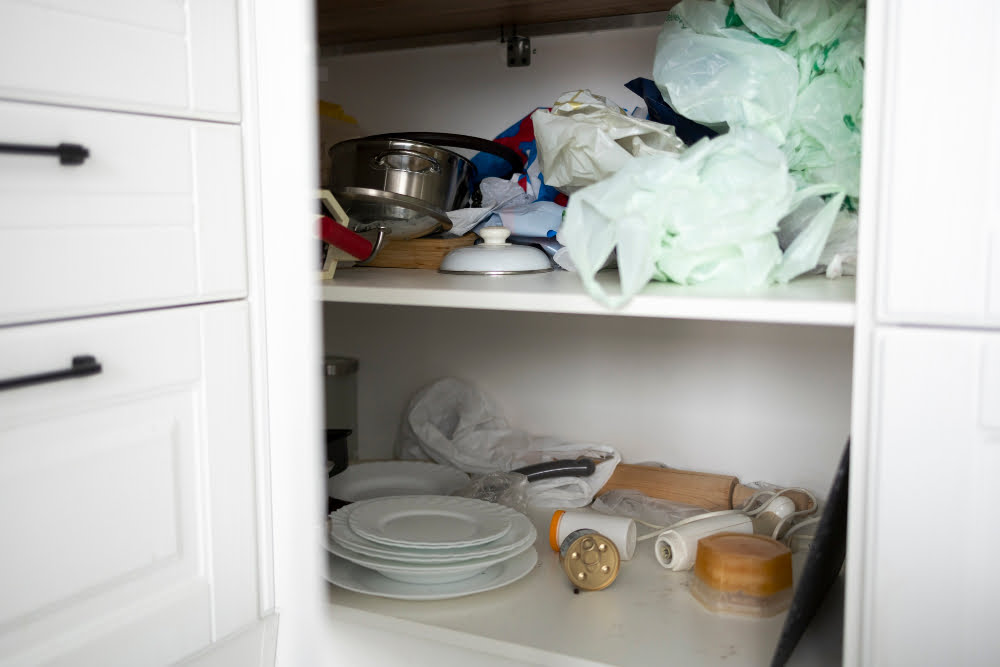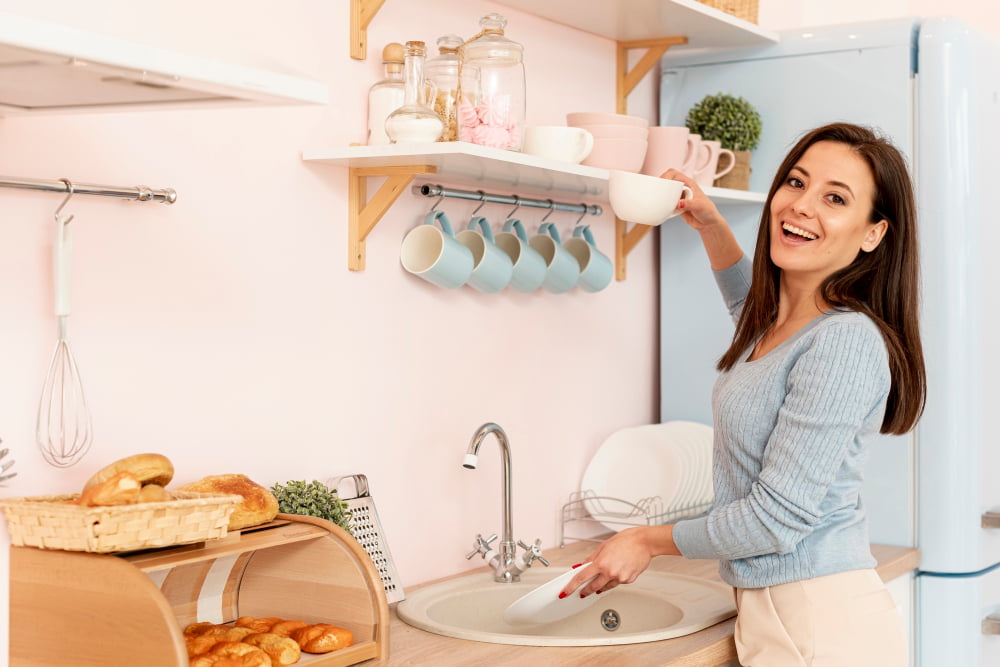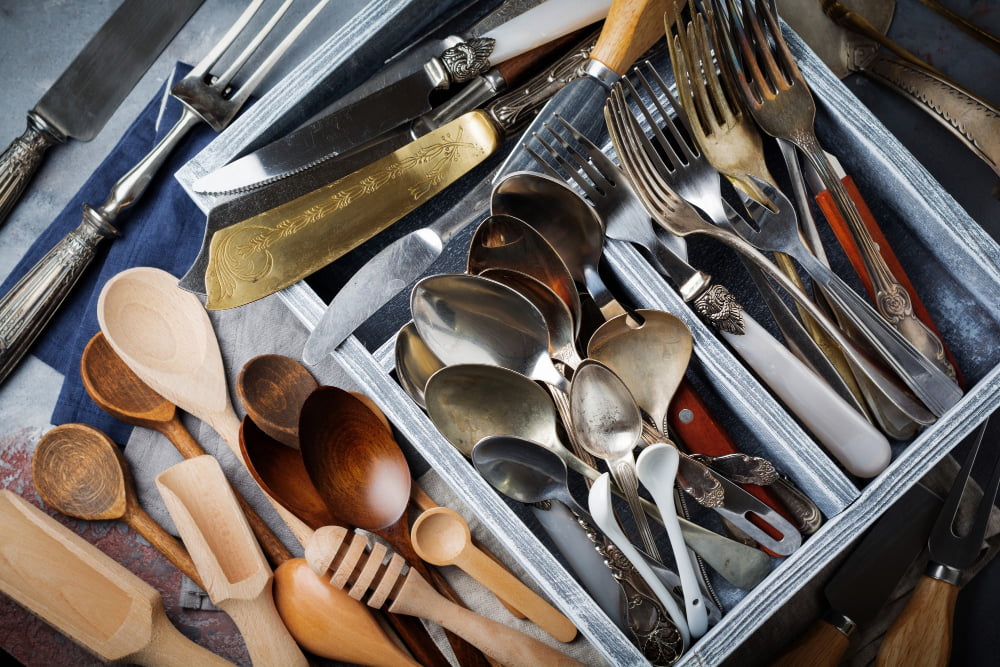Discover effective strategies to transform your kitchen into a clutter-free zone with these zero decluttering techniques.
Embarking on a kitchen zero declutter journey can transform your cooking and dining space into an efficient, serene, and enjoyable area.
This article will guide you through a step-by-step process to achieve a clutter-free kitchen, starting from sorting out utensils to organizing your pantry.
We’ll delve into practical strategies, including the ‘one-in, one-out‘ rule, optimal storage solutions, and how to maintain a minimalist kitchen over time.
So, if you’re ready for a kitchen transformation that will not only enhance your space but also your cooking experience, then keep reading for a comprehensive guide.
Key takeaways:
- Decluttering starts by recognizing culprits: surplus utensils, unused gadgets, expired food, and dinnerware.
- Steps to begin zero-waste decluttering: dispose of duplicates, broken items, and donate or recycle responsibly.
- Effective sorting and organizing techniques: categorize items by frequency of use, use FIFO technique for food storage, and utilize organizing helpers like hooks and baskets.
- Sustainable disposal of kitchen waste: donate items in good condition, recycle damaged items, compost food scraps, and use reusable containers.
- Benefits of a clutter-free kitchen: saves time, promotes eco-friendly lifestyle, encourages healthier eating habits, easier cleaning, and potential increase in home value.
Understanding Kitchen Clutter

When it comes to tackling clutter, the first step involves recognizing the culprits. Often, it’s the surplus utensils, unused gadgets, expired food items, and dinnerware that create disarray.
Also, spaces such as pantries and storage cupboards quickly become clutter repositories due to the “out of sight, out of mind” mentality. Grasping the factors that contribute to kitchen mess can provide enlightening insights, helping to set the right decluttering goals.
Whether it’s an excessive amount of dishes, a surge of spice jars, or a jungle of utensil drawers, identifying these issues is a critical first move toward achieving a well-organized kitchen.
Steps to Begin Zero-Waste Decluttering

Before embarking on the decluttering process, plan a day where you can devote some hours solely to this task. Break the kitchen process into segments such as cabinets, drawers, and countertops.
Start with the easy stuff. Dispose of duplicative items, broken objects, and gadgets that haven’t been put to use in over a year. But hold on before simply trashing these, remember the zero-waste part. Donate what is in good condition, sell items with value, and recycle whatever you can.
Next, address food packages. Toss expired products and compost scraps. Minimize plastic usage to master the zero-waste aspect. Opt for reusable containers and store perishable items in glass jars or beeswax wraps.
Finally, tackle the utensils and cookware. Retain only necessary items that aid in your cooking adventures, be it daily or occasionally.
Accomplishing this step prepares the ground for efficiency-boosting organization techniques. Remember, the rule of thumb for zero-waste decluttering is to responsibly dispose, recycle or donate.
Effective Sorting and Organizing Techniques

Begin by categorizing all kitchen items into ‘use frequently’, ‘use occasionally’, and ‘rarely used’. The first category should have items readily accessible, on the counter or the first shelf, the ‘occasionally’ used items can be placed in the kitchen cabinets, and for the ‘rarely used’, consider moving them to other storage areas outside of the kitchen.
For food storage, adopt the FIFO (First In, First Out) technique. Place older food items upfront and new purchases behind these, reducing food waste and ensuring expiry dates are kept in check.
Next comes categorizing utensils by type or function. Keep all baking items together, place all sharp knives in a secured location, group the various spatulas, spoons, and whisks, and finally gather all the pots and pans. Assigning a specific place for each category not only maintains cleanliness but also aids in efficient cooking.
Lastly, consider using organizing helpers like hooks for hanging mugs, baskets for root vegetables, and lazy susans for spices. A well-organized kitchen improves the cooking process, making it more enjoyable and less stressful.
Sustainable Disposal of Kitchen Waste

Take a moment to review each item you’re removing from your space. Consider donating items in good condition to thrift stores or charities.
Damaged pots, pans, or baking sheets can often be recycled, and old, unused spices or foods past its prime can be composted.
As much as possible, aim to repurpose, donate, recycle, or compost items instead of sending them to the landfill. However, certain items like broken ceramics or spoiled food might be exceptions.
Reusable containers can help reduce plastic bag usage, and composting promotes a greener environment.
Remember, each small step towards sustainable disposal contributes significantly to your zero-waste kitchen goal.
Creating a Functional, Minimalist Kitchen Space

Start by removing everything from your kitchen cabinets and counters. Restructure the spaces using clear bins or dividers to separate items.
Aim for open shelving to store frequently used items. This eases access and promotes visual sanitation.
Work surfaces should only house essential tools for immediate tasks. Less frequently used items must find a place inside cabinets or drawers.
Minimize your utensils and dishware count to only what’s necessary. There’s little need for multiple sets of identical utensils or an assortment of rarely used appliances. Donate or recycle extras responsibly. Handle kitchen-ware purchases more thoughtfully in the future.
Food pantry organization starts with grouping similar items together, for example, cans with cans, cereals with other breakfast items. Stackable clear plastic bins can be used to maximize space and maintain visibility.
Make a habit of completing what’s already open before starting on a new packet to avoid unnecessary wastage.
By making smart choices, you can convert your kitchen from a chaotic space into a functional, visually soothing minimalist area. Benefit from easy access, optimized workflow, and an enhanced aesthetic. This simplified approach can result in a seamless cooking experience, fueling a healthier attitude towards food and cooking.
Maintaining a Clutter-Free Kitchen Daily

Harnessing minimalistic habits is the key to keeping a tidy and serene cooking space.
Devote ten minutes each day to quick cleanups — wiping down counters, sorting dishes, and returning items to their designated spaces.
Make it a routine to clear your kitchen after each use.
Regular inspection of the fridge and pantry will enable you to get rid of aging or expired food timely, leaving space free.
A weekly deep-cleaning plan can also ensure that every drawer, shelf, and cupboard remains spotless and organized.
Lastly, every time you bring in something new, ask yourself what it’s replacing and remove redundant items.
Benefits of a Zero-Decluttered Kitchen

A clean, well-organized kitchen facilitates smoother preparation and cooking processes. With items easily located, it can save time and reduce the stress associated with searching for utensils or ingredients.
By maintaining a minimalist kitchen, you use only what’s truly necessary, minimizing waste and supporting an eco-friendly lifestyle.
Furthermore, it encourages healthier eating habits, since an orderly environment can promote better meal planning and discourage the habit of ordering take-out.
Less clutter also means easier cleaning, resulting in a hygienic, pleasant space for family meals and gatherings.
Lastly, this can potentially increase the value of your home, as a streamlined kitchen is often a key selling point for potential buyers.
Kickstarting Your Kitchen Declutter

Begin by removing everything from your kitchen cupboards and drawers. Place these items in an open space where you can take inventory.
Analyze each item critically. For those items you rarely use or have duplicates of, consider disposing of, donating, or re-purposing them elsewhere. Be practical in your assessment, removing emotions attached to these items.
Now, clean your empty storage spaces thoroughly, removing any grime or dust accumulated over time. With less clutter and a clean, fresh space to work with, you’re already making progress on your kitchen decluttering journey.
Minute Daily Clean-Up Tips

Begin each day by emptying the dishwasher, making it easy to put dirty dishes directly in it during the day.
Use idle time, like waiting for the microwave or coffee machine, to tidy up a drawer or wipe down the counters.
Keep cleaning supplies conveniently located for quick spills and stains.
Use the ‘sweeping method’ before bedtime: start at one end of the kitchen and ‘sweep’ your way to the other end, putting things back in their place.
Committing to these habits can make a big difference without requiring a lot of time.
Transforming Your Kitchen Space

It’s essential to look at the space with a fresh perspective. Firstly, empty out your cabinets and drawers, and group similar items – such as baking tools, cookware, utensils together.
It gives an idea of how many items you own and enables you to identify and discard duplicates.
Next, prioritize your kitchen items based on their frequency of use. Everyday essentials should be easily accessible, while seasonal or occasional items can be stored in higher or harder-to-reach cabinets.
Introduce efficient storage solutions. Use drawer dividers for utensils, a lazy Susan for spices, or a mounted holder for pots and pans. These can drastically improve the functionality of your space.
Lastly, devote space for non-cooking activities like a small home office or children’s homework area. Ensure these areas are neatly organized and equipped with appropriate storage to prevent cross-clutter. With this, you will have a transformed kitchen space that’s not only clutter-free but also custom-made for your lifestyle and needs.
Overhauling a Cluttered Storage Cupboard

To begin with, empty the entire cupboard and assess every item. Ask yourself the following questions: Have you used it in the past year? Is it still functional? Does it add value to your cooking routine? If the answer is no, consider disposing of it in an environmentally friendly way, or donate it if it’s still in good condition.
Next, categorize the remaining items based on their usage frequency. The most frequently used items should be placed at eye level or within easy reach. Infrequently used items can go on higher shelves.
Furthermore, consider employing drawer dividers or small containers to organize smaller objects. This helps you to easily locate them and keeps your cupboard from reverting back to a messy state.
Lastly, remember to keep a minimalist approach regarding future kitchen purchases to avoid clutter buildup. Adopt a ‘one-in, one-out’ rule whenever a new item is brought into the cupboard. This means if a new pan or dish makes its way into your kitchen, one older piece should be removed to maintain balance and space.
Decluttering Your Kitchen Counters

Begin with emptying all items off the counters, making sure to clean the surfaces thoroughly. This step gives you a blank canvas to reimagine your space.
Next, evaluate each item carefully. Ask yourself: How often is this item used? Does it have a space in the cabinets? Items frequently used are worth considering for counter space. Lesser-used items should be stored away.
Be strategic about appliance placement. Sometimes, it’s more practical to have appliances like toasters or blenders out on the countertop. Place these items where they are most comfortable to use without obstructing several tasks.
Store oft-used cooking tools – think spatulas, ladles, or whisks – in a neat countertop jar. This puts them within easy reach while cooking, but still keeps your counters looking organized.
Lastly, remember, your counters are not for storage. Keep only necessities out, and strive to create a steady habit of clearing spaces after use, to keep your counters declutter-ready at all times.
What’s Next in Your Kitchen Decluttering Journey?

Once your kitchen is streamlined and well-organized, the challenge lies in maintaining this state over time.
Focus on creating a new pattern of behavior.
When you use an item, return it to its dedicated space immediately after cleaning it.
Stick to the ‘one-in, one-out‘ rule to refrain from introducing new clutter.
Your pantry should not be a storage for multiples.
When you buy a new appliance, let an old one go.
Resist the temptation to display every piece of kitchenware you own, minimal visible clutter also means an uncluttered mind.
Regularly take stock of what you have and what you need, this habit will prevent over-purchasing.
Your kitchen is now a functional, clutter-free space, keep it that way for better peace of mind and an enhanced cooking experience.
FAQ
What are some practical, daily habits to maintain a decluttered kitchen?
Implementing habits like cleaning as you go, storing items in their designated spaces after use, organizing pantry goods by categories, doing nightly kitchen sweeps, utilizing wall and cabinet space, and periodically taking inventory of your items can assist in maintaining a decluttered kitchen.
How can kitchen items be organized to optimize workflow and efficiency?
Kitchen items can be optimized for workflow and efficiency by designating areas for specific tasks, storing items near their point of use, and implementing a system for decluttering and cleaning regularly.
What strategies can be used to declutter and organize a small kitchen space?
Optimizing a small kitchen space involves proactive decluttering, minimizing utensils and appliances, maximizing all available space including vertical areas and corners, categorizing items, maintaining a regular tidy-up schedule, and creating specific storage spots for each item.
Related Stories
- Organizing Your Kitchen: Tips for a More Functional and Efficient Cooking Space
- Decluttering Tips: 10 Easy Steps to Transform Your Space
- How to Declutter: A Comprehensive Guide for a Clutter-Free Home
- How to Declutter Apartment (20 Ideas)
- Decluttering Challenges: Fun and Effective Ways to Overhaul Your Home